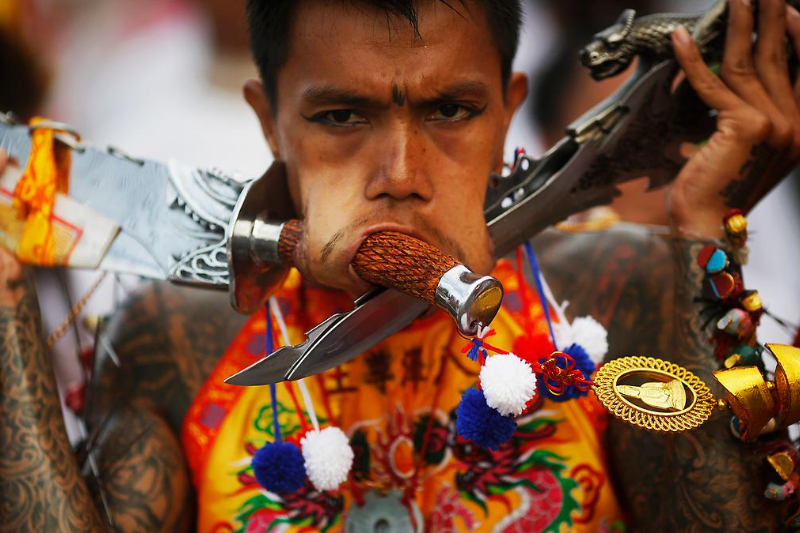- Sponsored -
Does entertainment spell a reckless loss of human lives in the name of culture?

With the speculation on Eid-al-Adha being a point of debate over the “rivers of blood” flowing through the streets of Dhaka, Bangladesh, the mass-killing and blood of animals turning streets red due to heavy rain, makes it a vile and ruthless sight. Nobody sees through the slaughtering of these animals all year round and although condemning or supporting these acts is a violation of religious beliefs, what does one do when the subject is woven into the society’s basic unit: humans?
- Sponsored -
A plethora of festivals revolve around the idea of violence throughout different parts of the world. As though there aren’t enough wars, personal and national, taking lives by the hour, these only seem to be an excuse to settle scores and prove their mettle. What doesn’t seem to come as a surprise here is that most people voluntarily indulge in these heinous and atrocious activities so that others can gape, gawk and ogle at their bravery.
To name a few festivals isn’t a Herculean task as these have been popularized for their dangerous levels of insanity and loss of lives. The Jallikattu festival in Tamil Nadu, India, that was banned in 2014 by the Supreme Court on the grounds of the animals being harmed and used as performing animals and the safety of the animal and the general public being compromised. Yet, the ban was challenged and a Jallikattu Premier League was instead organised in February 2018 to protest the stay on the ban. Between 2008 and 2014, 43 humans and 4 bulls were killed in the Jallikattu events. In 2017, there were 23 deaths in addition to about 2,500 human injuries and several instances of injury to the bulls.
Animal welfare concerns are related to the handling of the bulls before they are released and also during competitor’s attempts to subdue the bull. Practices, before the bull is released, include prodding the bull with sharp sticks or scythes, extreme bending of the tail which can fracture the vertebrae, and biting the bull’s tail. There are also reports of the bulls being forced to drink alcohol to disorient them, or chilli peppers being rubbed in their eyes to aggravate the bull.
During attempts to subdue the bull, they are stabbed by various implements such as knives or sticks, punched, jumped on and dragged to the ground. Invariants in which the bull is not enclosed, they may run into traffic or other dangerous places, sometimes resulting in broken bones or death. Protestors claims that Jallikattu is promoted as bull taming, however, others suggest it exploits the bull’s natural nervousness as prey animals by deliberately placing them in a terrifying situation in which they are forced to run away from the competitors which they perceive as predators and the practice effectively involves catching a terrified animal. Along with human injuries and fatalities, bulls themselves sometimes sustain injuries or die, which people may interpret as a bad omen for the village.
Another life-threatening festival is the Onbashira festival in Japan, that takes place every six years in April or May, where people brave the steep mountainsides and narrow rivers in lake Suwa where huge logs of wood are transported to the Suwa Taisha. As they finally reach the top of the mountain, a part of the journey involves Kiotoshi where the motive is to stay on and only to slide down riding those logs of wood, albeit recklessly. Injuries and deaths have occurred during the festival in past years, though being killed by one of the trees is considered to be an honorable death.
San Fermin in Pamplona, Spain, requires no explanation with its level of atrocity being extreme. The number of injuries due to people stumbling or being gored by the horns of raging, 500 kilograms weighing bulls being left into an 850-metre bull ring around the city.
Some other examples of these “cultural” sports include the Matador Dorris, Vegetarian Festival, Crucifixion re-enactment, Yanshui Beehive Rockets Festival, etc. The gory details of the deaths and injuries caused due to such festivals know no numbers. Why then do we succumb to societal pressure under the garb of proving our mettle or entertaining the masses at large? What prices do we have to pay to for living in society under the disguise of culture as though racial segregation, sparse societal conditions and divisions in society weren’t enough for people to cause commotions and simultaneous death? Isn’t it high time that we think rationally instead of emotionally and break the shambles that dictate the rules for our lives at the cost of culture?
Whether humanity goes from being only a race that has reached the moon but killed its own kind over resplendently, cultured smiles is an idea most of us must ponder upon. And soon.
- Sponsored -
